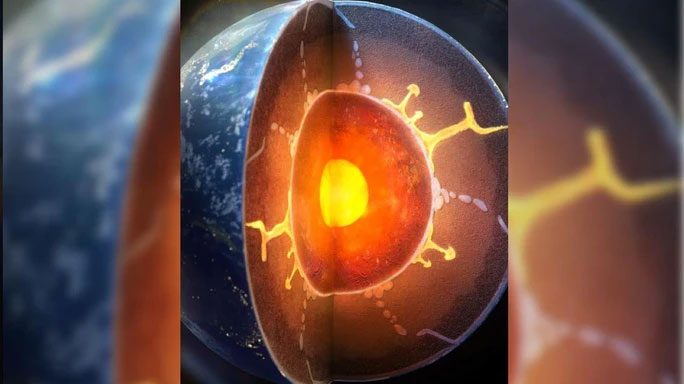A series of new experiments have unveiled the mystery of the “E-Prime layer” of the Earth, a layer that has not been mentioned in mainstream literature and appears to have formed quite late.
According to Live Science, this is a mysterious crystalline layer surrounding the Earth’s core. It began to come to light from a 1990 study, but no one could explain it.
The basic model of the Earth consists of the crust, upper mantle, lower mantle, outer core, and inner core. The E-Prime layer, also known as E’, lies between the lower mantle and the outer core of the planet, measuring just over 100 km in thickness.

Internal structure of the Earth – (Photo: ASU).
Previously, scientists believed that the E’ layer was formed from ancient iron-rich magma, with some hypotheses suggesting it was due to materials leaking from the interior, or remnants of a planet or protoplanet that once collided with the Earth.
Recent research published in the journal Nature Geoscience indicates that the E’ layer may have formed through both of the previously mentioned pathways.
One possibility is leakage, but it is leakage from the outside in, as surface water gradually seeps down to the core-mantle boundary over time, influenced by tectonic processes.
This layer of water reacted with the metallic surface of the outer core, thereby creating a new layer for the Earth.
A series of experiments based on known properties of the Earth demonstrated this, replicating how water could react with the outer core under the extreme pressures of that deep region.
Hydrogen from the water has replaced silica in the liquid metal at the surface of the outer core, pushing silica out in crystalline form, resulting in a layer that is particularly rich in hydrogen and poor in silica.
Scientists also estimate that this layer has taken 1 billion years to reach its current thickness.
“For many years, it was believed that the material exchange between the mantle and crust was minimal, but these discoveries indicate a much more dynamic and significant interaction,” concluded Dr. Dan Shim, a geologist from Arizona State University (ASU), co-author of the study.


















































